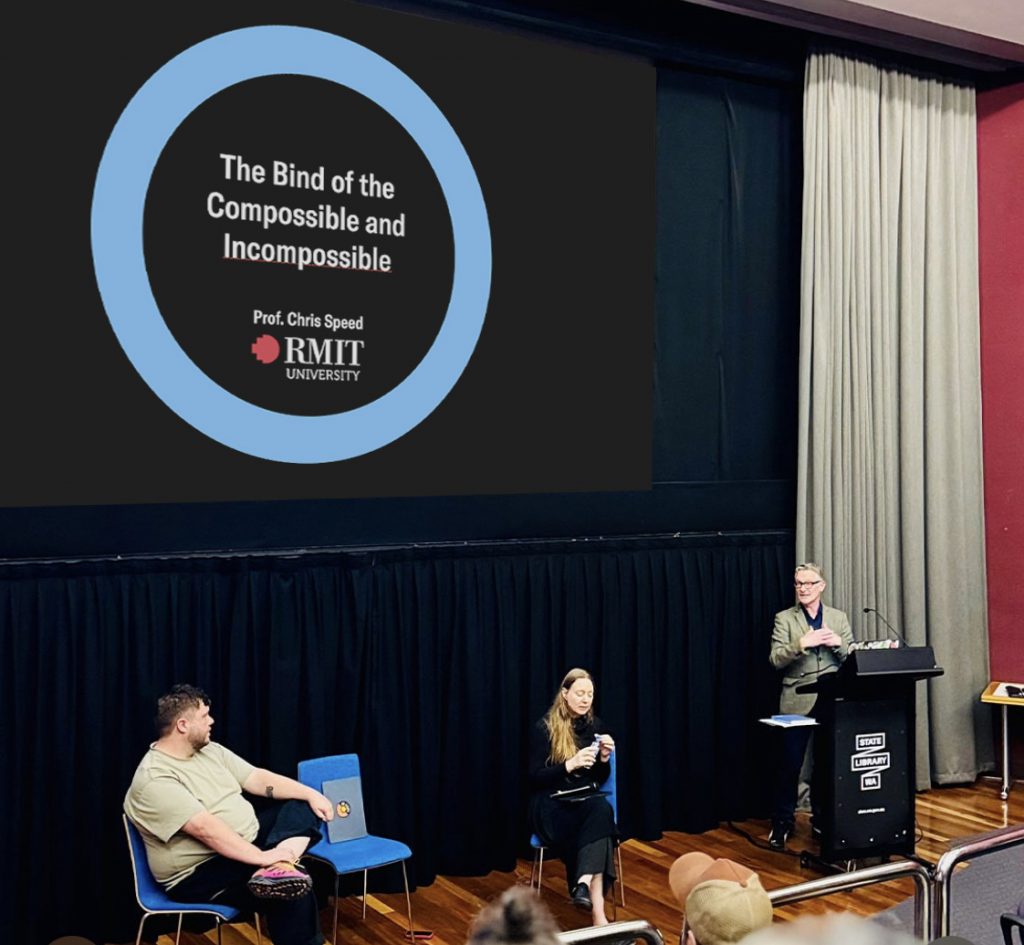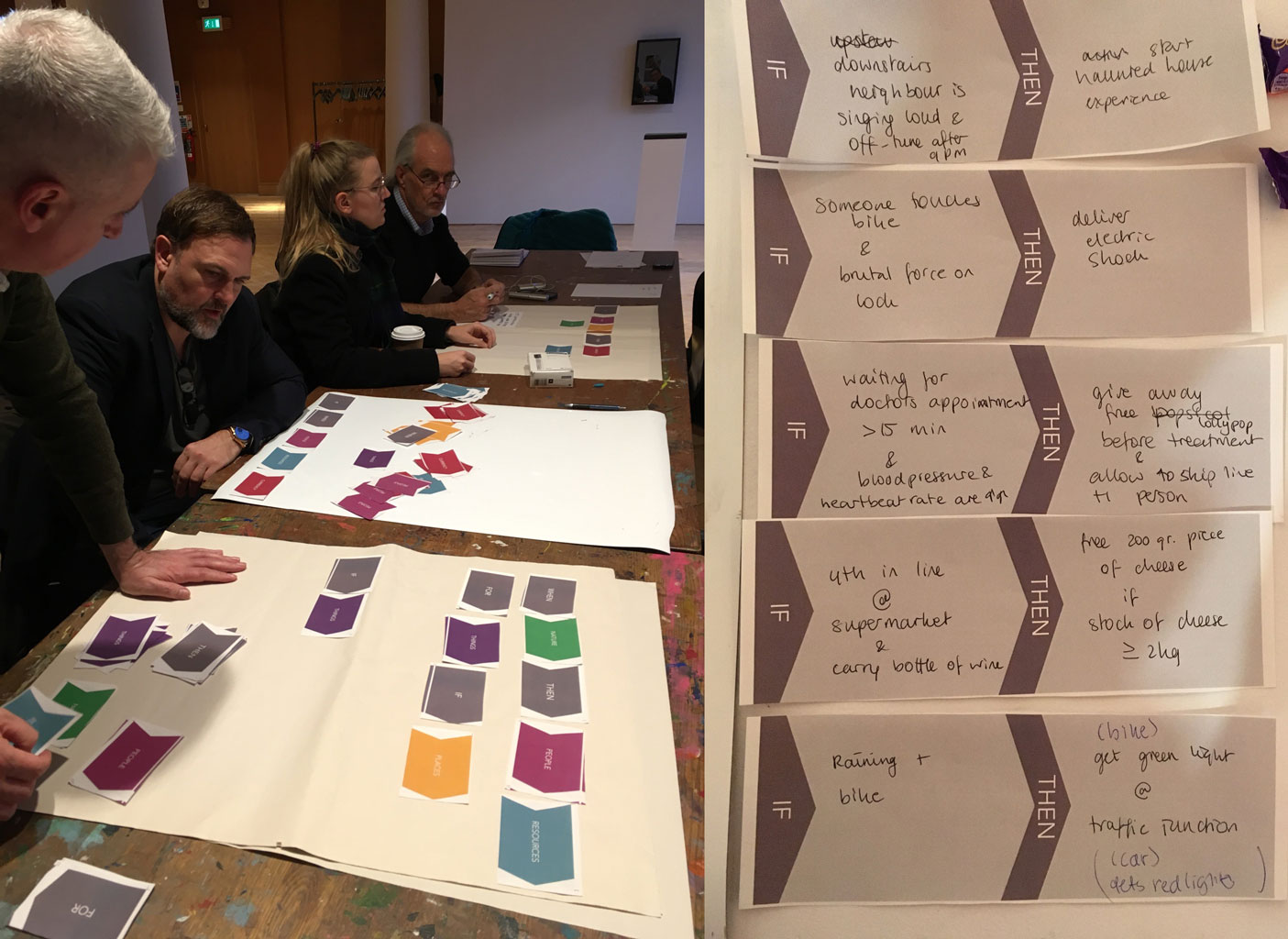New Economic Imaginaries
Amongst the works that have emerged through the ‘after money’ related projects which include the AHRC Design in Action, ESRC After Money, EPSRC OxChain and EPSRC PETRAS, a series of products and platforms have provoked a line of thought to consider the extent to which interaction with these prototypes are able to impact upon the economic imaginaries of the participants. This post explores what imaginaries are, and how they are both disrupted and produced through Design Informatics prototypes.
In previous blogs I’ve concluded with a product or service that has emerged from either the involvement in a workshop or teaching programme that has used tools to introduce new technologies: GeoCoin led to Civic Blocks and Handfastr / bitcoin marriages, Predictive Materialities led to the KASH Cups, and investigations into new forms of governance through DAOs led to Edson Alcala Garrdio’s Democrachain. This post reflects on the extent to which these platforms have the capability to disrupt existing imaginaries about the flow, representation and practice of value (at least temporarily) in order for participants to construct new ones.
Or they don’t.
The word imaginary has become such a useful term to describe both the challenges that the research faces (revealing hegemonies), but also in the potential to offer form to new imaginaries through sense and meaning making.
A quick google will reveal perfectly good interpretations of what an imaginary is:
“the creative and symbolic dimension of the social world, the dimension through which human beings create their ways of living together and their ways of representing their collective life”. John B. Thompson, Studies in the Theory of Ideology (1984) p.6
“imaginaries are patterned convocations of the social whole. These deep-seated modes of understanding provide largely pre-reflexive parameters within which people imagine their social existence-expressed, for example, in conceptions of ‘the global,’ ‘the national,’ ‘the moral order of our time.'”
Steger, Manfred B.; James, Paul (2013). “‘Levels of Subjective Globalization: Ideologies, Imaginaries, Ontologies'”. Perspectives on Global Development and Technology. vol. 12 (no. 1-2): 23.
But Bob Jessop, offered the most useful definition that seemed most relevant to the imaginaries that are associated with economics:
“An imaginary is a semiotic ensemble (or meaning system) that frames individual subjects’ lived experience of an inordinately complex world and/or guides collective calculation about that world. There are many imaginaries and most are loosely- bounded and have links to other imaginaries within the broad field of semiotic practices. They exist at different sites and scales of action – from individual agents to world society (Althusser 1977; Taylor 2004). Without them, individuals cannot ‘go on’ in the world and collective actors (such as organizations) could not relate to their environments, make decisions, or engage in strategic action. In this sense, imaginaries are an important semiotic moment of the network of social practices in a given social field, institutional order, or wider social formation (Fairclough 2003). Let me now address the four above-mentioned aspects of imaginaries.” Cultural Political Economy, Spatial Imaginaries, Regional Economic Dynamics, 2012.
In his 2013 lecture below, Jessop extends the complexity of social imaginaries (scrub to 15’18”):
Everyone must simplify the real world to ‘go on’ within it: this involved different entry points and standpoints.
Imaginary designates these simplifications: it involves:
– selective observation of real (natural and social) world,
– reliance on specific codes and programmes,
– use of certain categories and forms of calculation,
– sensitivity to specific structure of feeling,
– reference to particular identities,
– justification in terms of particular vocabularies of motives,
– efforts to calculate short to long term interests.
At 16’27” Jessop uses the following diagram to describe the apparent tension between semiosis (‘sense and meaning making’) and ‘structuration: managing the compossible’. Describing semiosis as “an umbrella concept for all forms of the production of meaning that is oriented to communication among social agents, individual or collective.” Whilst “structuration establishes possible connections and sequences of social interaction (including interaction with the natural world) so that they facilitate routine actions and set limits to path-shaping strategic actions”. (IBID)
It is across these tensions that two Design Informatics projects are beginning to reveal the extent to which our prototypes and platforms are beginning to reveal the limits of economic imaginaries but also the possible.
BitBarista
“Bitbarista is a Bitcoin coffee machine, designed and built, as part of the STiPS project, to demonstrate the properties and potential of Bitcoin, and explore perceptions of value transactions with a novel Internet of Things device. It’s comprised of a hacked Delonghi coffee machine enhanced with a Raspberry Pi which reads signals from the coffee machines sensors, controls its functions, and connects it to the Internet. It is also fitted with a small camera to read smart codes so it can make Bitcoin payments directly to customers’ Bitcoin wallets. This enables it to offer payment to customers for performing maintenance tasks such as refilling coffee beans, filling its water tank, and cleaning out used coffee grounds.”
“Bitbarista serves coffee in exchange for a Bitcoin contribution towards its future coffee supply. Coffee beans used to make the coffee served will have been selected collectively by previous customers. In order to assist customers in considering future supplies Bitbarista displays data on the state of coffee-producing countries looking for information on climate, work conditions, political situation, infrastructure, price stability and demand, which the machine purportedly browses online. From this data the machine selects top-ranked options for coffee beans in 4 categories: best quality, lowest price, lowest environmental impact and highest social responsibility. It then offers users the opportunity to choose one of these options for its next supply, and customers pay for their coffee accordingly. After the purchase, a new screen situates the choice within the pool of choices previously made, all anonymised, displaying the supply most likely to be ordered next. The aim of this interaction is to create transparency around the process of engaging with coffee supply chains, with the intention of creating a positive experience of data sharing in this context.” Ella Tallyn, Bitbarista team, Design Informatics.
Augmenting the need for a coffee (consumption) with a decision-making process (governance) offers a small way in which DAOs, or in PWCs continuum DABUs (Distributed Autonomous Business Units), can begin to perform code that tends us toward making decisions that might slow down the apocalypse.
However, through interviews from the 2017 CHI paper, findings suggested that some participants expressed uncertainty about the business model behind Bitbarista as their economic imaginary recovered assumptions that somebody must own the machine, and that some sort of profit would be made by someone:
“I’m not exactly sure where the revenue is being directed and to whom. I just don’t know who actually, um, makes money from this, whether it is somebody who sells it, or if it gives money back to the coffee producers, or…this is the one I’m not certain about” (P7). P5 reflected on how profit would be made through the commercialisation of data “if there’s somebody who was to buy the data from the company, or, you know, if the company was selling data or the manufacturers or the, the coffee growers were then selling the data or accessing the data”. P4 questioned if the model would work for other entities in the supply chain, “I mean the whole bitcoin thing you are going for, in these developing countries, I don’t know how that works for someone in Ethiopia who probably doesn’t own a computer, I don’t understand how this translates for everyone else”. Larissa Pschetz, Ella Tallyn, Rory Gianni, and Chris Speed. 2017. Bitbarista: Exploring Perceptions of Data Transactions in the Internet of Things. In Proceedings of the 2017 CHI Conference on Human Factors in Computing Systems (CHI ’17). ACM, New York, NY, USA, 2964-2975. DOI: https://doi.org/10.1145/3025453.3025878
GeoCoin Cinema
During the introduction, Jessop outlines the ‘project’ for the lecture as:
“How can we develop distinct patterns of material practices and material cultures that are transformative and lead to development and not merely quantitative growth?” (9′ 10″)
Whilst BitBarisa has caused a positive reaction in stirring the imaginations of what the Autonomous Economic Agents of the future may be ( BBC Click, 2017), we have been offering an extension to the GeoCoin workshops that encourages participants to ‘perform’ the designs of their smart contracts.
Citing the forthcoming CHI paper that demonstrates the role of GeoCoin as a ideation tool:
“We developed GeoCoin as an explorative platform for location based, or geo-fenced currencies to allow researchers and designers to engage wider audiences in understanding and designing with novel infrastructures of smart contracts and cryptocurrencies. Smart contract logic is attached to physical locations, and participants interact with them using a smartphone app that shows the contract instances on a map as the participants move through space. The app maintains a digital currency wallet for each person, so that participants can see changes to their balance in real-time. It currently includes two basic types of smart contract: i) Debit/credit coins which perform a single transaction with the first participant who comes within the radius of the contract; ii) Debit/credit zones which continually add or remove currency from all participants within their radius. The value of each coin or zone is not visible to users, and only becomes apparent through physical exploration and observing the changes to one’s balance. The zones can be easily administered through a web interface, allowing workshop organisers and designers to quickly set up new experiences alongside participants.” Bettina Nissen, Larissa Pschetz, Dave Murray-Rust, Hadi Mehrpouya, Shaune Oosthuizen, Chris Speed 2018. GeoCoin: Supporting Ideation and Collaborative Design
with Smart Contracts. In Proceedings of the 2018 CHI Conference on Human Factors in Computing Systems (CHI ’18). ACM, New York, NY, USA.
Following a short ‘body storming’ experience in the street based upon the scattering of coins by workshop leaders, participants are invited back to the workshop to design their own economic settings that function according to the deployment of smart contracts.
After identifying a context and an ‘imaginary’ in which social practices are influenced by a business model in which value flows between actors depending upon their actions, participants are asked to use simple cards to plan out the rules for the smart contracts. Based upon an adaptation of the simple logic ‘If This Then That’ the cards prompt participants to decide on how they should deploy the GeoCoin smart contracts across the local area.
Always successful in helping people understand the potential for smart contracts, the workshops tended to end with the deployment of the contracts in the software and it was only recently that we encouraged participants to move outside and ‘practice’ the imaginary.
What follows in the video below, are three participants of a GeoCoin workshop who have ‘re-imagined’ a business model for cinema.
The difficulty (or excitement) is in the viewing having to suspend disbelief that the participants are engaged in a new economic imaginary that involves going to a cinema, that doesn’t exist…
Following his explanation of the tension that occurs between sinnmachung (semiosis) and structuration, Jessop describes the contested nature of imaginaries suggesting that:
“Imaginaries are not pre-given mental categories but creative products of semiotic and material practices that have more or less performative power.” (23’42”)
It is probably too ambitious to suggest that the practices of our participants have ‘sedimented’ to form any robust new economic imaginaries, it is interesting and indeed exciting to see how participation in the design of smart contracting business models is able to lead to viable non-representational practices.
Related posts

“This communication is not for you.”
Looking to connect 2 recent events / conversations (as is my want) this time to explore a fundamenta

Design Frequencies: Sharing International Practice in Design Research
Already deep into semester two here. Last semester School of Design RMIT College of Design and Socia

The Labour of the Rejected / “Walk the Plank”
Still playing catchup with so many events. A few weeks ago during hashtag#DIS2025, Mafalda Gamboa an

Design Contradictions
Two projects during Melbourne Design Week with collaborators Michael Dunbar and Liam Fennessy to exp

Paradox of Collaborative Speed
Two events in Melbourne over the past 10 days week revealed a tension across contemporary technology

Slow Materials, Slow Money: Can Design Decelerate?
Two events that I’m trying to tie together to glean some connections. The CHI panel on Regenerativ

From Food Networks to AI Governance
Back to reporting on events in Narme/Melbourne. From Food Networks to AI Governance: Reflections on

Planetary Pedagogies
Following the launch of PlanetaryCivics two weeks ago, this is the second extension to contributions

Space Debris to House Keys
Part 2 of catching up with the weeks of activity in Melbourne through February. From Space Debris to

Measuring our demise
Oh Melbourne, three parallel events that spanned the week: RMIT College of Design and Social Context


